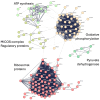Skeletal Muscle Involvement in Friedreich Ataxia
- PMID: 39337401
- PMCID: PMC11432698
- DOI: 10.3390/ijms25189915
Skeletal Muscle Involvement in Friedreich Ataxia
Abstract
Friedreich Ataxia (FRDA) is an inherited neuromuscular disorder triggered by a deficit of the mitochondrial protein frataxin. At a cellular level, frataxin deficiency results in insufficient iron-sulfur cluster biosynthesis and impaired mitochondrial function and adenosine triphosphate production. The main clinical manifestation is a progressive balance and coordination disorder which depends on the involvement of peripheral and central sensory pathways as well as of the cerebellum. Besides the neurological involvement, FRDA affects also the striated muscles. The most prominent manifestation is a hypertrophic cardiomyopathy, which also represents the major determinant of premature mortality. Moreover, FRDA displays skeletal muscle involvement, which contributes to the weakness and marked fatigue evident throughout the course of the disease. Herein, we review skeletal muscle findings in FRDA generated by functional imaging, histology, as well as multiomics techniques in both disease models and in patients. Altogether, these findings corroborate a disease phenotype in skeletal muscle and support the notion of progressive mitochondrial damage as a driver of disease progression in FRDA. Furthermore, we highlight the relevance of skeletal muscle investigations in the development of biomarkers for early-phase trials and future therapeutic strategies in FRDA.
Keywords: Friedreich Ataxia; biomarker; frataxin; mitochondria; proteomics; skeletal muscle; transcriptomics.
Conflict of interest statement
The authors declare no conflicts of interest.
Figures


References
-
- Campuzano V., Montermini L., Moltò M.D., Pianese L., Cossée M., Cavalcanti F., Monros E., Rodius F., Duclos F., Monticelli A., et al. Friedreich’s ataxia: Autosomal recessive disease caused by an intronic GAA triplet repeat expansion. Science. 1996;271:1423–1427. doi: 10.1126/science.271.5254.1423. - DOI - PubMed
-
- Rodden L.N., Chutake Y.K., Gilliam K., Lam C., Soragni E., Hauser L., Gilliam M., Wiley G., Anderson M.P., Gottesfeld J.M., et al. Methylated and unmethylated epialleles support variegated epigenetic silencing in Friedreich ataxia. Hum. Mol. Genet. 2020;29:3818–3829. doi: 10.1093/hmg/ddaa267. - DOI - PMC - PubMed
Publication types
MeSH terms
Substances
LinkOut - more resources
Full Text Sources
Medical

